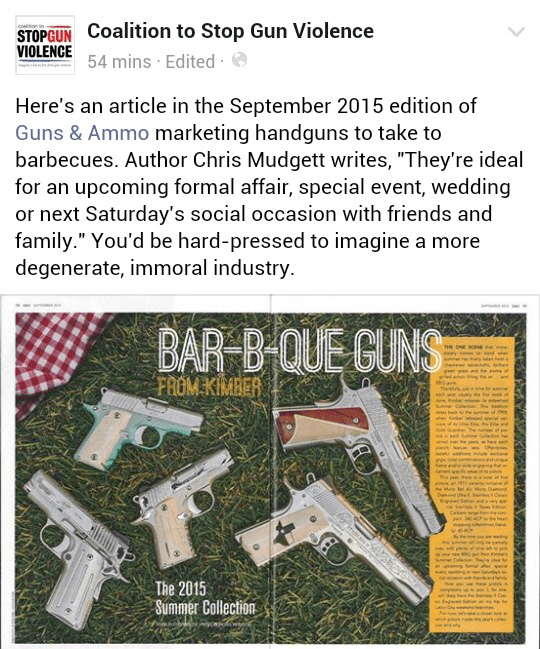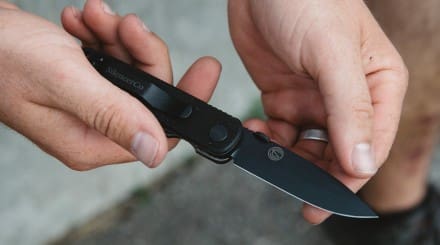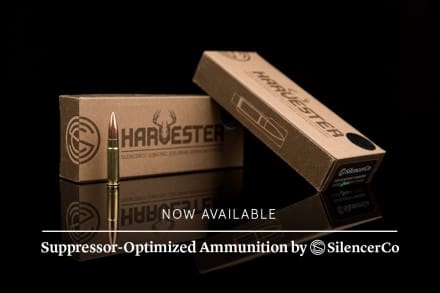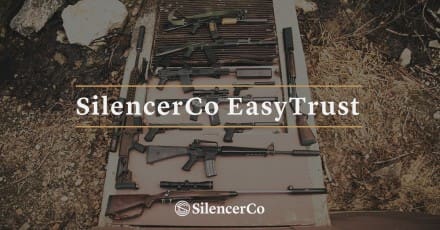Archive for the ‘2A’ Category
ATF Goes All #Mythbusters
Thursday, December 10th, 20152016 NDAA Contains Provision To Offer 100,000 M1911A1 Pistols Via Civilian Marksmanship Program
Monday, November 30th, 2015The day before Thanksgiving, President Obama signed the 2016 National Defense Authorization Act into law. While one of its most sweeping changes is the creation of a new retirement plan for military personnel, an interesting provision in the legislation which will transfer up to 100,000 M-1911A1 pistols to qualified recipients via the Civilian Marksmanship Program. Previously, CMP has been limited to transferring rifles such as the M-1 Garand.
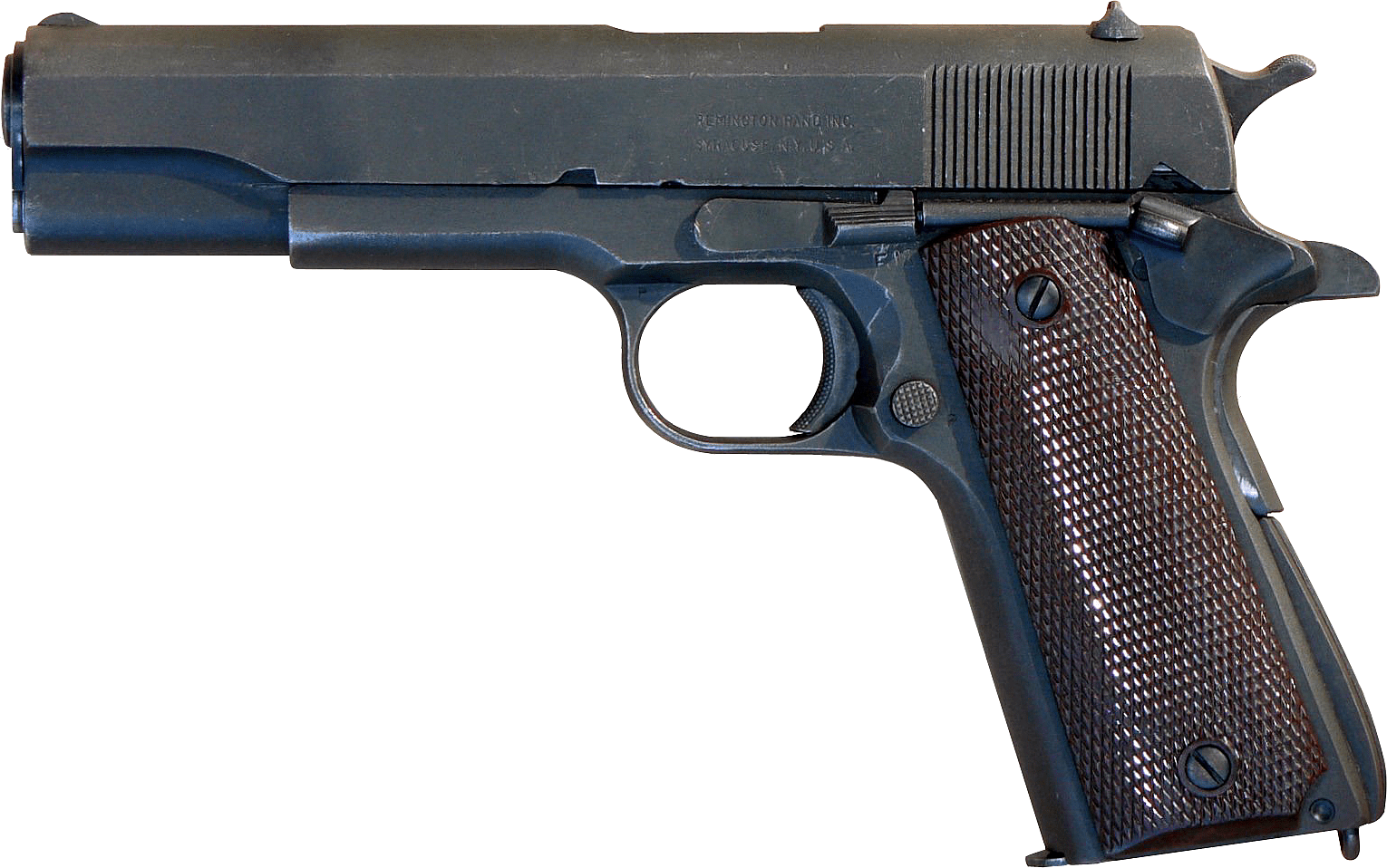
The program will begin with a one-year pilot effort which will transfer up to 10,000 pistols. Further details are below.
SEC. 1087. TRANSFER OF SURPLUS FIREARMS TO CORPORATION FOR
(a) AUTHORIZATION OF TRANSFER OF SURPLUS FIREARMS TO CORPORATION FOR THE PROMOTION OF RIFLE PRACTICE AND FIRE- ARMS SAFETY.— (1) IN GENERAL.—Section 40728 of title 36, United States Code, is amended by adding at the end the following new subsection:
THE PROMOTION OF RIFLE PRACTICE AND FIREARMS SAFETY.
S. 1356—288
‘‘(h) AUTHORIZED TRANSFERS.—(1) Subject to paragraph (2), the Secretary may transfer to the corporation, in accordance with the procedure prescribed in this subchapter, surplus caliber .45 M1911/M1911A1 pistols and spare parts and related accessories for those pistols that, on the date of the enactment of this subsection, are under the control of the Secretary and are surplus to the require-ments of the Department of the Army, and such material as may be recovered by the Secretary pursuant to section 40728A(a) of this title. The Secretary shall determine a reasonable schedule for the transfer of such surplus pistols.
‘‘(2) The Secretary may not transfer more than 10,000 surplus caliber .45 M1911/M1911A1 pistols to the corporation during any year and may only transfer such pistols as long as pistols described in paragraph (1) remain available for transfer.’’.
(2) TECHNICAL AND CONFORMING AMENDMENTS.—Such title is further amended—
(A) in section 40728A—
(i) by striking ‘‘rifles’’ each place it appears and inserting ‘‘surplus firearms’’; and
(ii) in subsection (a), by striking ‘‘section 40731(a)’’ and inserting ‘‘section 40732(a)’’; (B) in section 40729(a)—
(i) in paragraph (1), by striking ‘‘section 40728(a)’’ and inserting ‘‘subsections (a) and (h) of section 40728’’; (ii) in paragraph (2), by striking ‘‘40728(a)’’ and inserting ‘‘subsections (a) and (h) of section 40728’’; and
(iii) in paragraph (4), by inserting ‘‘and caliber .45 M1911/M1911A1 surplus pistols’’ after ‘‘caliber .30 and caliber .22 rimfire rifles’’;
(C) in section 40732—
(i) by striking ‘‘caliber .22 rimfire and caliber .30 surplus rifles’’ both places it appears and inserting ‘‘surplus caliber .22 rimfire rifles, caliber .30 surplus rifles, and caliber .45 M1911/M1911A1 surplus pistols’’; and
(ii) in subsection (b), by striking ‘‘is over 18 years of age’’ and inserting ‘‘is legally of age’’; and (D) in section 40733—
(i) by striking ‘‘Section 922(a)(1)-(3) and (5)’’ and inserting ‘‘(a) IN GENERAL.—Except as provided in sub-section (b), section 922(a)(1)-(3) and (5)’’; and
(ii) by adding at the end the following new sub-
section: ‘‘(b) EXCEPTION.—With respect to firearms other than caliber .22 rimfire and caliber .30 rifles, the corporation shall obtain a license as a dealer in firearms and abide by all requirements imposed on persons licensed under chapter 44 of title 18, including maintaining acquisition and disposition records, and conducting background checks.’’.
(b) PILOT PROGRAM.—
(1) ONE-YEAR AUTHORITY.—The Secretary of the Army may carry out a one-year pilot program under which the Secretary may transfer to the Corporation for the Promotion of Rifle Practice and Firearms Safety not more than 10,000 firearms described in paragraph (2).
S. 1356—289
(2) FIREARMS DESCRIBED.—The firearms described in this paragraph are surplus caliber .45 M1911/M1911A1 pistols and spare parts and related accessories for those pistols that, on the date of the enactment of this section, are under the control of the Secretary and are surplus to the requirements of the Department of the Army.
(3) TRANSFER REQUIREMENTS.—Transfers of surplus caliber .45 M1911/M1911A1 pistols from the Army to the Corporation under the pilot program shall be made in accordance with subchapter II of chapter 407 of title 36, United States Code.
(4) REPORTS TO CONGRESS.—the Secretary initiates the pilot program under this sub-section, the Secretary shall submit to Congress an interim report on the pilot program. Secretary completes the pilot program under this sub-section, the Secretary shall submit to Congress a final report on the pilot program. this subsection shall include, for the period covered by the report—
(A) INTERIM REPORT.—Not later than 90 days after
(B) FINAL REPORT.—Not later than 15 days after the
(C) CONTENTS OF REPORT.—Each report required by
(i) the number of firearms described in subsection
(a)(2) transferred under the pilot program; and
(ii) information on any crimes committed using firearms transferred under the pilot program.
(c) LIMITATION ON TRANSFER OF SURPLUS CALIBER .45 M1911/M1911A1 PISTOLS.—The Secretary may not transfer firearms described in subsection (b)(2) under subchapter II of chapter 407 of title 36, United States Code, until the date that is 60 days after the date of the submittal of the final report required under subsection (b)(4)(B).
Additionally, the law requires the Department of Defense to develop procedures allowing military personnel to carry personally owned firearms on base, pursuant to local laws.
Mudge Smash Monday
Monday, November 30th, 2015ASA Announces Hearing Protection Act: A Bill To Remove Suppressors From The NFA
Friday, October 23rd, 2015For too long we’ve seen legislation move closer and closer toward banning firearms. It’s great to see the American Suppressor Association take the opposite tack and move the goal posts toward less regulation. In particular, the classification of suppressors as NFA items is particularly shortsighted considering their value in protecting the hearing of gun owners and bystanders alike. And let’s not forget our pets and working animals who may be exposed to shooting.
WASHINGTON, D.C. – The American Suppressor Association (ASA) is pleased to announce the introduction of the Hearing Protection Act (HPA) by Rep. Matt Salmon (AZ-05). This historic piece of legislation will remove suppressors from the purview of the National Firearms Act (NFA), replacing the antiquated federal transfer process with an instantaneous NICS background check. The HPA also includes a provision to refund the $200 transfer tax to applicants who purchase a suppressor after October 22, 2015.
“The American Suppressor Association believes that citizens should not have to pay a tax to protect their hearing while exercising their Second Amendment rights,” said Knox Williams, President and Executive Director of the ASA. “The removal of suppressors from the National Firearms Act has been our ultimate goal since day one. For months, we have worked alongside Rep. Salmon’s office and the National Rifle Association to craft this legislation. Although we recognize that introducing this bill is the first step in what will be a lengthy process to change federal law, we look forward to working with Rep. Salmon and the NRA to advance and ultimately enact this common-sense legislation.”
Also known as silencers, suppressors are the hearing protection of the 21st century sportsman. Despite common Hollywood-based misconceptions, the laws of physics dictate that no suppressor will ever be able to render gunfire silent. Suppressors are simply mufflers for firearms, which function by trapping the expanding gasses at the muzzle, allowing them to slowly cool in a controlled environment. On average, suppressors reduce the noise of a gunshot by 20 – 35 decibels (dB), roughly the same sound reduction as earplugs or earmuffs. In addition to hearing protection, suppressors also mitigate noise complaints from those who live near shooting ranges and hunting lands.
Unfortunately, suppressors have been federally regulated since the passage of the National Firearms Act of 1934. The NFA regulates the transfer and possession of certain types of firearms and devices, including suppressors. Currently, prospective buyers must send in a Form 4 application to the ATF, pay a $200 transfer tax per suppressor, undergo the same background check that is required to purchase a machine gun, and wait months for the ATF to process and approve the paperwork. In stark contrast, many countries in Europe place no regulations on their purchase, possession, or use.
Rep. Salmon’s Hearing Protection Act will fix the flawed federal treatment of suppressors, making it easier for hunters and sportsmen to protect their hearing in the 41 states where private suppressor ownership is currently legal, and the 37 states where hunting with a suppressor is legal. This legislation will remove suppressors from the onerous requirements of the NFA, and instead require purchasers to pass an instant NICS check, the same background check that is used during the sale of long guns. In doing so, law-abiding citizens will remain free to purchase suppressors, while prohibited persons will continue to be barred from purchasing or possessing these accessories.
www.AmericanSuppressorAssociation.com
“If Only There Was A Law…”
Monday, August 31st, 2015If only there was a law against murder, all of these killings would stop.
As we all know, depending on the jurisdiction there are multiple statutes against different types of murder, conspiring to murder, using certain implements to murder, depraved indifference to murder and so on. Yet, it continues to happen.
Never Let A Tragedy Go To Waste
The anti-2A agenda takes every opportunity to call for “common sense” gun control measures, including the most recent horrible murders, where the perpetrators took advantage of social media to spread their agendas of hate.
In the case of the Charleston church murderer, Dylann Roof, the government failed to enforce current legislation by allowing him to purchase a gun in spite of a drug arrest. More recently, Virginia murderer Bryce Williams purchased his gun legally. Yet, none of the current, or proposed firearms legislation would have prevented either of those fiends from violating one of the most fundamental precepts of modern society, “Thou Shalt Not Kill.”
Murder, It’s Illegal, And Yet They Persist
Despite the quote I led the story with, murder is already against the law. Short of developing crime precognition and arresting those who plan to kill, there are no laws that will stop a determined murderer. If they ignore our most basic laws and the sanctity of life, why would we ever expect them to obey gun laws?
Individual Responsibility
Individual responsibility was long the cornerstone of our country’s strength. Now, we have a very vocal element of our society that doesn’t want to hold the individual responsible. Instead, they’d rather blame inanimate objects; like guns and knives, as if the evildoer were the victim.
I personally don’t believe that anyone who commits murder is in their right mind, but that doesn’t mean they are insane either. Conversely, one can be certifiable, unaware of the consequences of their actions, and still do things that are against the law. To be sure, most perpetrators know exactly what they are up to, but the punishment associated with murder doesn’t deter them. We can’t stop evil in men’s hearts but we can counter their actions, if we are prepared to take reaponsibility for our own safety and that of our loved ones.
Some acknowledge evil, and yet their answer is prohibition. They want to ban all firearms hoping that this will stop murder. But, making it harder for law abiding citizens to defend themselves is no answer either.
We need look no further than another instance of prohibition for the answer. As a society we have banned drugs. And yet, our prisons are full of those convicted of trafficking in drugs as well as associated crimes. The criminal element has ended any debate. If guns are outlawed, outlaws will have them, and the citizenry will be left at their mercy. If we want crime and helplessness to sky rocket in America, simply disarm our law-abiding citizens.
More Laws Aren’t The Answer
It’s high time that the anti-gun agenda abandon its tactic of blaming firearms for the acts of criminals and begin to look at enforcing existing laws, as well as effective mental health care. It’s not going to stop all criminal activity, but it will certainly will help.
As for the truly evil ones? I don’t think we’ll ever stop them, but at least the rest of us can defend ourselves, so long as we are armed.
SilencerCo – Emerson A-100 Mini, Subsonic 300 BLK, And EasyTrust
Friday, August 7th, 2015SilencerCo and Emerson Knives have partnered up, producing a small run of SilencerCo-branded A-100 Minis.
Specifications
OAL: 7.20”
Blade Length: 3.00”
Blade Thickness: 0.125”
Blade Material: 154CM
Blade Style: Spear Point
Edge Type: Plain
Frame/Liner: Titanium & 300-Series Stainless Steel
Knife Type: Manual
Opener: Thumb Disk
Lock Type: Liner Lock
Finish: Black
www.store.silencerco.com/products/silencerco-branded-emerson-folding-knife
SilencerCo’s 300 BLK Harvester ammo is optimized for suppressors. It’s loaded with a 220gr Sierra MatchKing bullet, and manufactured to produce sub-MOA accuracy.
harvesterammo.com/220gr-sierra-matchking
SilencerCo offers a simplified, inexpensive method to set up a NFA Firearms Trust through their EasyTrust service. The benefits of an NFA trust include:
– A More Simple Process Overall
– No Fingerprint Cards
– No Photographs
– No Chief Law Enforcement Officer Signoff
– Multiple People Can Have Possession of Items
– Clear Line of Inheritance for Items on Trust
– File Form 1’s Electronically via eForm
– File Form 4’s Electronically Once eForm 2.0 is Operational
For more information, visit: silencerco.com/nfa-trust
Reminder – Obama Administration Moves To Restrict ITAR Related Free Speech
Tuesday, July 28th, 2015Back in June, we reported on a recent proposed rule change to the International Traffic in Arms Regulations (ITAR) which, according to the Federal Register website would:
…amend the International Traffic in Arms Regulations (ITAR) to update the definitions of “defense article,” “defense services,” “technical data,” “public domain,” “export,” and “reexport or retransfer” in order to clarify the scope of activities and information that are covered within these definitions and harmonize the definitions with the Export Administration Regulations (EAR), to the extent appropriate.
This rule change would expand the definition of what digital information could be classified as ITAR restricted, including but certainty not limited to the firearms industry.
One aspect of these proposed changes that was implied but not blatantly addressed is the restriction it could place on 3D printed firearms and components. Technical data including “blueprints, drawings, photographs, plans, instructions or documentation.” would become restricted from “export”, or being published on the internet, which includes 3D printer files for firearms and components. We’ve already seen a restriction on 3D firearms plans when Defense Distributed was told to remove the plans for the Liberator Pistol from their website.
But what can I do?
You can comment. This rule change hasn’t taken effect yet and you can let the Federal Government know how you feel about this proposal by providing feedback.
If you are going to do so, we suggest these pointers:
We suggest you use your own voice, keep it civil, direct and to the point, and use proper grammar to be most effective. Do not use a form letter. They carry less weight than individualized comments.
What The Heck Is This ‘Charleston Loophole’ I Keep Hearing About?
Tuesday, July 21st, 2015Lately, gun grabbers have been calling for an end to the ‘Charieston Loophole’. The problem is, I can’t figure out what it is.
According to FBI Director James Comey, Charleston Church shooter Dylann Roof should not have been able to purchase a handgun, but that the National Criminal Background Check System which is used to determine whether a firearms purchaser can legally do so, made a mistake. As far as I can tell, there’s no loophole here.
Dylan’s Roof didn’t exploit a “loophole” in the law. There’s a system that’s been in place for years and should have denied hisirxhase and referred him to local authorities. But that system didn’t work. Unfortunately, this ‘mistake’ resulted in prohibited person purchasing a firearm who then used it to murder good people. People died at a prayer meeting as a result of the FBI’s negligence.
What should be done is a hard look at the inefficiency of the National Criminal Background Check System and a reckoning for those who don’t enforce existing firearms laws and don’t follow up when prohibited persons attempt to purchase them.
Maybe I’m wrong, and you can explain this ‘Charieston Loophole’ to me?



